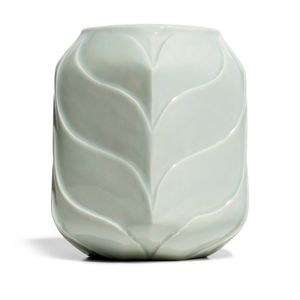Miyanaga Tozan III Celadon Vase with Water Ripples
A Japanese modernist vase by Miyanaga Tozan III (1935-), Heisei period (1989-2019), circa 1990, moulded in hexagonal form, with carved abstracted water ripples to the surface, covered in a pale bluish-green celadon glaze. Carved signature reading "III Tozan Miyanaga" to the base, and an exhibition number "7". Together with its tomobako (original signed Japanese wooden box), and an exhibition pamphlet, 23.5 cm high, 23 cm diameter. Other Notes: Miyanaga Rikichi became the third Miyanaga Tozan in 1999 on the death of his father. A master of celadon glazes like his forbears his works are often sculptural reflecting his long association with the avant-garde Sodeisha movement,
You must be a subscriber, and be logged in to view price and dealer details.
Subscribe Now to view actual auction price for this item
When you subscribe, you have the option of setting the currency in which to display prices to $Au, $US, $NZ or Stg.
This item has been sold, and the description, image and price are for reference purposes only.
- Circa - A Latin term meaning 'about', often used in the antique trade to give an approximate date for the piece, usually considered to be five years on either side of the circa year. Thus, circa 1900 means the piece was made about 1900, probably between 1895 and 1905. The expression is sometimes abbreviated to c.1900.
- Modernism / Modernist - Modernist furniture and design emerged in the early to mid-20th century as a response to traditional styles of the 19th century and prior times, and a reflection of the technological and social changes of the time. Characteristics of Modernist furniture and design include simplicity and minimalism and clean lines and a lack of unnecessary ornamentation are key features. That form follows function is a fundamental principle of Modernist design, and furniture and objects are designed with a focus on their practical use.
Modernist furniture often incorporates geometric shapes, such as cubes, rectangles, and circles. This reflects a departure from the more ornate and curvilinear forms of previous design styles. The furniture often prioritizes ergonomic design, ensuring that objects are comfortable and user-friendly. Modernist designers aimed to create designs that could be mass-produced, making good design accessible to a broader population.
Prominent figures associated with Modernist furniture and object design include designers such as Hans Wegner, Verner Panton, Florence Knoll, Harry Bertoia and Ettore Sottsass
This item has been included into following indexes:
- Japanese ceramics, item types - monumental, exhibition floor and oversize vases 61
- Japanese ceramics, styles and decoration - celadon glazed 47
-
Satsuma (Japan), item type
- boxes 111
- vases, floor standing 37
